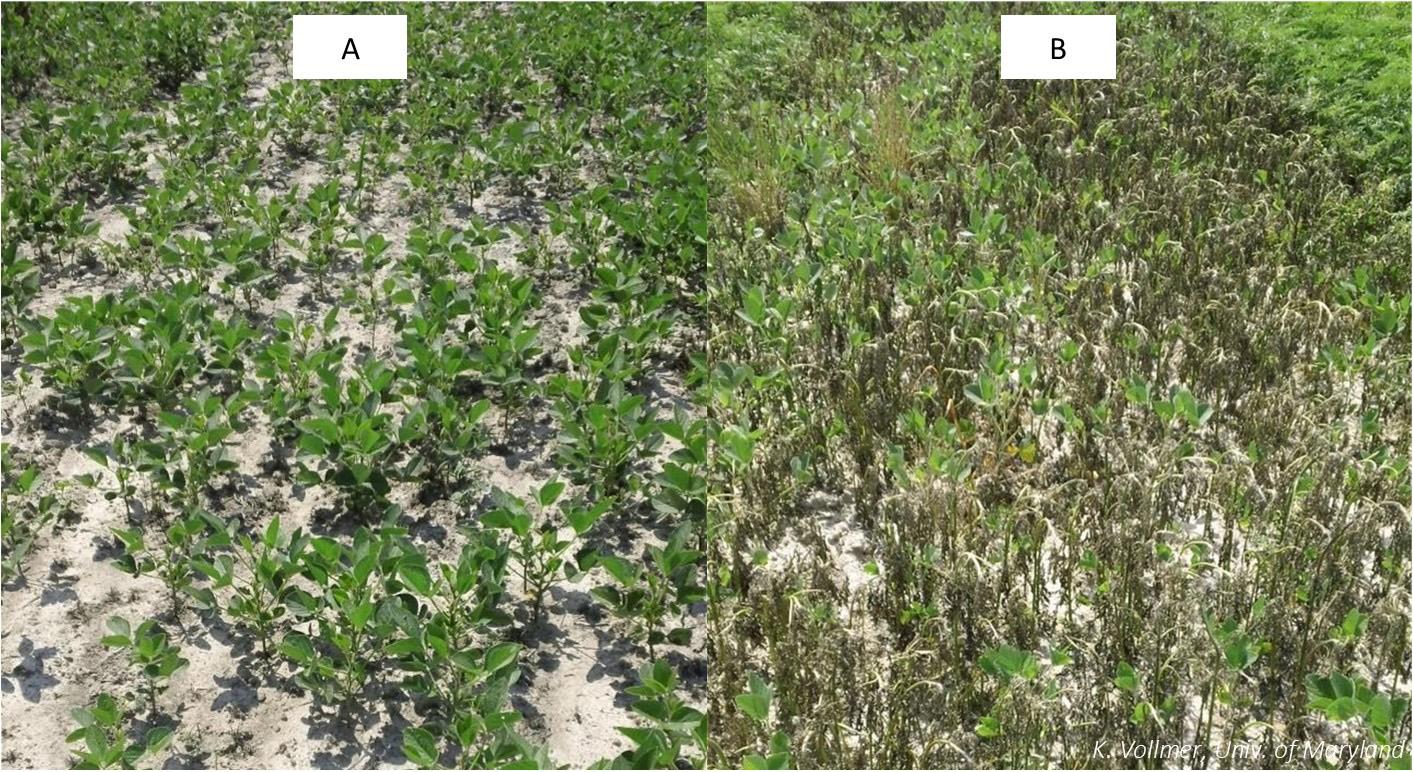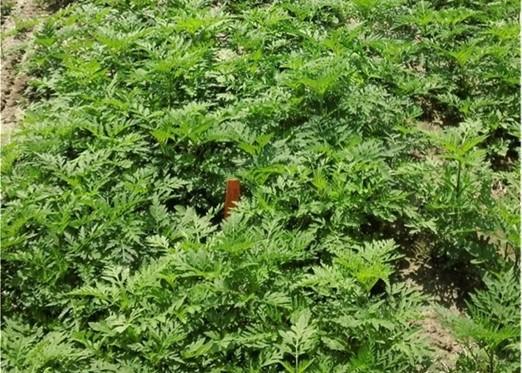Options for Postemergence Common Ragweed Control in Enlist E3 Soybean
Introduction
In Maryland, populations of common ragweed have developed resistance to three herbicide groups, Group 9 (glyphosate), Group 2 (FirstRate, Synchrony), and Group 14 (Flexstar, Valor). These herbicide-resistant populations limit options for effective postemergence control. Even though alternative herbicides are available, control can be inconsistent when applied to common ragweed plants exceeding 4” tall (Figure 1).
Objectives
The objectives of this study were to 1) evaluate the efficacy of single and sequential herbicide applications, and 2) evaluate the efficacy of herbicide tank-mixes applied at two different heights for controlling large common ragweed.
Methods
Two studies were conducted in a field with a history of herbicide-resistant common ragweed in Snow Hill, MD. The first study evaluated single or sequential applications of Liberty (1.8 pt/A), Enlist One (2 pt/A), and Flexstar (1.6 pt/A) alone or in tank-mixes (Table 1). The second study evaluated Roundup (22 oz/A), Liberty (29 oz/A), and Enlist One (32 oz/A) applied alone or in tank mixes to 6 to12” tall or 14 to18” tall common ragweed. Dry ammonium sulfate (3 lb/A) was included in all treatments containing Roundup, Liberty, or Flexstar. The field was tilled prior to planting to ensure a clean seedbed and Enlist E3 soybeans (tolerant to 2,4-D, glyphosate, and glufosinate) were drilled in 15 inch rows on May 4, 2021 at a rate of 52 lb/A. Herbicide treatments for both studies were applied on June 8, to 6 to 12 inch tall common ragweed, and a second postemergence application was made 15 days later on June 23.
|
Treatment |
Application Aᶻ |
Application Bʸ |
||
|---|---|---|---|---|
| Product(s) | Rate (pt/A) | Product(s) | Rate (pt/A) | |
| 1 | Libertyˣ | 1.8 | - | - |
| 2 | Liberty |
1.8 |
Liberty | 1.8 |
| 3 |
Liberty + Enlist One |
1.8 + 2 |
- | - |
| 4 |
Liberty + Enlist |
1.8 + 2 | Enlist One | 2 |
| 5 | Enlist One | 2 | - | |
| 6 | Enlist One fb Enlist One |
2 | Enlist One | 2 |
| 7 | Enlist One | 2 | Enlist One + Flexstar | 2 + 1.6 |
| 8 | Enlist One | 2 | Liberty + Enlist One | 1.8 + 2 |
| 9 | Enlist One + Flexstarʷ | 2 +1.6 | Enlist One | 2 |
| 10 | Flexstar | 1.6 | - | - |
| 11 | Flexstar | 1.6 | Enlist One | 2 |
| 12 | Liberty + Enlist One | 1.8 + 2 | Flexstar | 1.6 |
| 13 | Enlist One + Flexstar + Liberty | 2 + 1.6 + 1.8 | - | - |
|
z Treatments applied June 8, 2021. |
||||
Results
Study 1: On June 17, prior to the sequential applications, all treatments except those for which only Enlist One was applied, controlled common ragweed 92 to 94% (Figure 2). On July 12, all treatments that included a tank mix and/or sequential application controlled common ragweed 93 to 100%. Control with single applications of Liberty and Flexstar declined to 83% and 79%, respectively. Control with the single application of Enlist One improved to 92% and was not different from sequential or tank mix treatments, nor was it different from a single application of Liberty.

Study 2: On July 1, most treatments controlled common ragweed better when applied to 6 to 12” plants compared to 14 to 18” plants (Figure 3a). Roundup + Liberty and Enlist One + Liberty controlled common ragweed at least 94%, regardless of plant height. However, control with Liberty alone was better when applied to 14 to 18” tall ragweed compared to 6 to 12” tall ragweed. Although control was better when Roundup alone was applied to smaller plants, average control was only 25%. This was likely due to the presence of glyphosate-resistance in the common ragweed population. By July 12, most applications made earlier to 6 to 12” plants controlled ragweed better than applications made later to 14 to 18” tall plants (Figure 3b). Enlist One and tank mixes of Enlist One, Roundup, and/or Liberty controlled ragweed greater than 93%, when applied to 6 to 12” plants, but control ranged from 46% to 87% when the same treatments were allied to 14 to 18” tall plants.

Discussion
These results emphasize the importance of timely postemergence herbicide applications in controlling common ragweed. Delaying applications increases the likelihood that common ragweed will not be controlled with a single herbicide application. In the first study, there was an 11% and a 15% decrease in control with Liberty alone and Flexstar alone, respectively. In the second study, there was a 6 to 26% decrease with Liberty alone over time. Spray coverage is an important factor when using these two herbicides. Spraying taller weeds results in less herbicide coverage, and if full coverage is not achieved, plants can recover from herbicide injury. Furthermore, labeled rates for herbicides are based on recommended weed sizes, and often cannot be increased to account for larger weeds. Spraying larger weeds results in non-lethal herbicide doses being applied, which can increase selection pressure and lead to additional herbicide-resistant biotypes. In order to maximize control of herbicide-resistant common ragweed and mitigate additional resistance development, large plants should be managed with sequential applications and/or tank-mixes. Sequential applications, even with a single herbicide such as Liberty or Enlist One, can ensure that fewer ragweed remain at the end of the season. Herbicide tank mixes can complement one another by providing synergism, even when a lethal dose of each herbicide is not applied. However, applications should still be made as early as possible, because even tank-mixes can be less effective when common ragweed becomes too large (Figure 4).

Acknowledgments
This study was funded by the Maryland Soybean Board. The author would also like to thank Donny Powell, Shana Burke, and James Houck for their assistance in implementing and maintaining this project.
This article appears on November 2021, Volume 12, Issue 8 of the Agronomy news.
